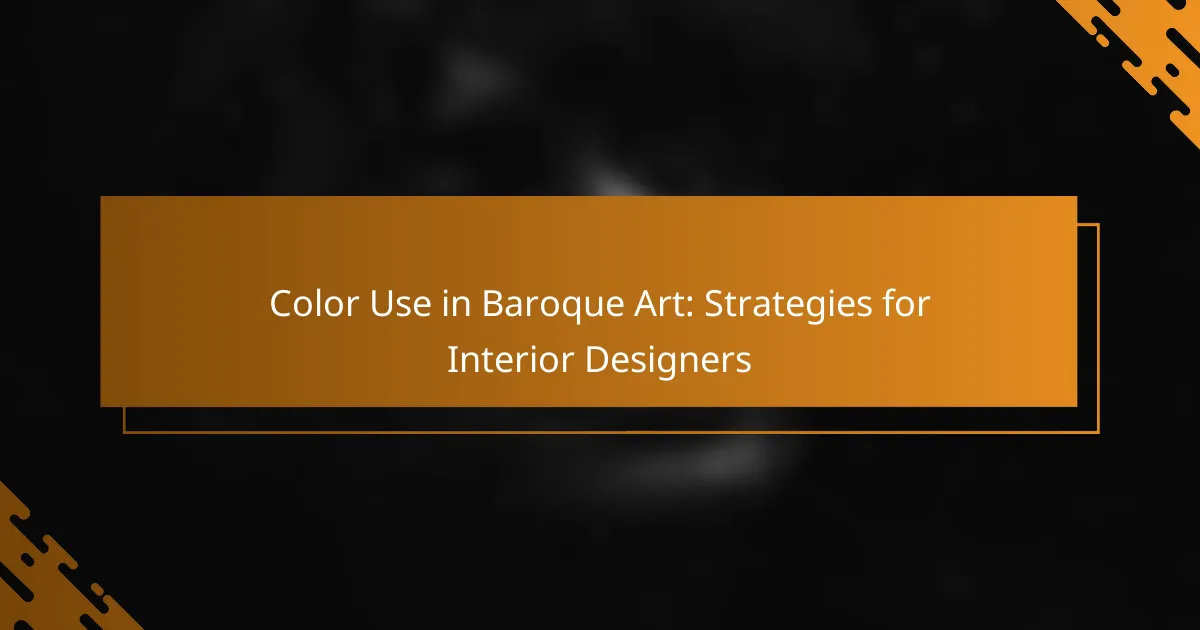Color strategies play a crucial role in Baroque-inspired interiors, enhancing the sense of drama and opulence typical of this artistic period. By utilizing rich hues and thoughtful contrasts, designers can evoke grandeur while creating luxurious and inviting spaces that resonate emotionally with occupants.

How can color strategies enhance Baroque-inspired interiors?
Color strategies can significantly enhance Baroque-inspired interiors by creating a sense of drama and opulence. Utilizing rich hues and thoughtful contrasts can evoke the grandeur characteristic of this artistic period, making spaces feel both luxurious and inviting.
Rich color palettes
Baroque interiors often feature rich color palettes that include deep reds, golds, blues, and greens. These colors can be used on walls, furnishings, and decorative elements to create a cohesive and sumptuous environment. For instance, a deep burgundy wall paired with gold accents can evoke the lavishness of Baroque design.
When selecting colors, consider using jewel tones or muted earth tones that reflect the historical context. A combination of dark and light shades can add depth and interest to the space, enhancing the overall aesthetic.
Contrasting hues
Contrasting hues are essential in Baroque design, as they create visual tension and highlight architectural features. Pairing light and dark colors, such as cream with navy or soft pastels with rich jewel tones, can draw attention to specific areas and add dynamism to the interior.
To effectively use contrasting hues, apply them strategically—perhaps on a feature wall or in upholstery. This approach can help to define spaces within an open floor plan while maintaining a cohesive look.
Layering textures
Layering textures is a key strategy in Baroque-inspired interiors, enhancing the richness of color schemes. Combining materials such as velvet, silk, and brocade can create a tactile experience that complements the visual appeal of the colors used.
Incorporate various textures through textiles, wall coverings, and decorative accessories. For example, a velvet sofa with silk cushions can create an inviting seating area that reflects Baroque opulence.
Accent colors
Accent colors play a crucial role in Baroque-inspired designs, providing focal points that enhance the overall color scheme. Using bold accents, such as a vibrant yellow or a striking teal, can enliven a space and draw attention to specific features like artwork or architectural details.
When choosing accent colors, consider the primary palette and select shades that complement rather than clash. A well-placed accent can transform a room, adding energy and interest without overwhelming the design.
Historical references
Incorporating historical references through color can deepen the Baroque aesthetic in interiors. Drawing inspiration from famous Baroque artworks or architecture can guide color choices and overall design themes.
Researching historical color schemes used in Baroque palaces or churches can provide valuable insights. For example, the use of gold leaf in paintings can inspire the addition of gold accents in modern interiors, creating a connection to the past while maintaining contemporary relevance.

What are key Baroque color principles for interior design?
Key Baroque color principles for interior design focus on creating a sense of drama, using rich tones, and incorporating symbolism. These strategies enhance the emotional impact of a space, making it feel both luxurious and expressive.
Emphasis on drama
Baroque design thrives on dramatic contrasts and bold color choices. Darker shades paired with lighter hues create visual tension, drawing the eye and evoking strong emotions. For instance, deep reds or blacks can be used alongside bright whites or golds to amplify the overall impact.
When implementing this principle, consider using accent walls or statement furniture pieces in contrasting colors. This approach can transform a room from ordinary to extraordinary, making it a focal point for attention.
Use of gold and jewel tones
Gold and jewel tones are hallmarks of Baroque interiors, symbolizing wealth and opulence. Rich colors like emerald green, sapphire blue, and ruby red can be integrated through textiles, wall coverings, or decorative elements. These hues not only add depth but also create a luxurious atmosphere.
In practical terms, aim to use these colors in moderation to avoid overwhelming the space. For example, a jewel-toned sofa paired with gold accents can create a striking yet balanced look. Consider fabrics that reflect light, enhancing the richness of the colors.
Symbolism in color choices
Colors in Baroque art often carry symbolic meanings, which can be effectively utilized in interior design. For example, blue may represent tranquility, while red can signify passion or power. Understanding these associations allows designers to create spaces that resonate emotionally with occupants.
To apply this principle, select colors that align with the intended mood of the room. For instance, a study might benefit from calming blues, while a dining area could thrive with warm reds and golds. This thoughtful approach enhances the overall narrative of the space.

Which Baroque color schemes are popular in modern design?
Modern design often incorporates Baroque color schemes that emphasize richness and depth. Popular choices include deep reds and golds, muted earth tones, and monochromatic palettes, each offering unique aesthetic benefits.
Deep reds and golds
Deep reds and golds are quintessential Baroque colors that evoke luxury and warmth. These hues can create a dramatic atmosphere in interiors, making them ideal for spaces like dining rooms or libraries.
When using deep reds, consider pairing them with gold accents to enhance the opulence. For example, a rich burgundy wall can be complemented with gold-framed mirrors or light fixtures, creating a cohesive and inviting space.
Muted earth tones
Muted earth tones draw inspiration from nature and provide a calming backdrop in Baroque-inspired designs. Colors like terracotta, olive green, and soft browns can be used to create a warm and inviting environment.
These tones work well in living areas or bedrooms, where a serene atmosphere is desired. To achieve balance, combine earth tones with textured fabrics and natural materials, such as wood or stone, for a harmonious look.
Monochromatic schemes
Monochromatic schemes utilize varying shades of a single color, offering a sophisticated and cohesive design approach. This strategy can highlight architectural features while maintaining a sense of unity throughout the space.
For instance, a palette of different blues can create a tranquil environment, especially when layered with various textures. Incorporate accessories in lighter or darker shades to add depth without overwhelming the overall aesthetic.

How to select paint colors inspired by Baroque art?
Selecting paint colors inspired by Baroque art involves choosing rich, deep hues that evoke the opulence and drama characteristic of the period. Focus on colors like gold, deep reds, and royal blues, which can create a luxurious atmosphere in your space.
Color matching tools
Utilizing color matching tools can help you find the perfect shades reminiscent of Baroque art. Tools such as color swatches, digital apps, and online palettes allow you to visualize how different colors interact in your environment. Look for tools that provide historical color references to ensure authenticity.
Consider using a color wheel to understand complementary and contrasting colors. This can guide you in creating a balanced yet dynamic palette that reflects the Baroque style.
Sample testing
Before committing to a color, conduct sample testing on your walls. Purchase small paint samples and apply them to a section of the wall to see how they look in different lighting throughout the day. This will help you gauge the color’s impact in your space.
Testing multiple shades side by side can also reveal how they harmonize with existing furnishings and decor. Aim for a range of colors that capture the essence of Baroque art while still fitting your personal style.
Consulting design professionals
Consulting design professionals can provide valuable insights into selecting Baroque-inspired colors. Interior designers often have experience with historical styles and can recommend specific shades that align with your vision. They can also help you navigate the complexities of color theory and application.
When working with a designer, discuss your preferences and the overall mood you want to achieve. Their expertise can ensure that your color choices enhance the architectural features of your space while maintaining the richness of Baroque aesthetics.

What are the best materials to complement Baroque color schemes?
The best materials to complement Baroque color schemes include rich fabrics, ornate woods, and luxurious metals. These materials enhance the dramatic and opulent aesthetic characteristic of Baroque design, creating a cohesive and sophisticated interior environment.
Luxurious fabrics
Luxurious fabrics play a crucial role in achieving the Baroque aesthetic. Materials such as silk, velvet, and brocade are ideal choices, as they add depth and richness to the color palette. These fabrics often feature intricate patterns and textures that reflect the grandeur of the Baroque period.
When selecting fabrics, consider using deep jewel tones like emerald green, royal blue, or rich burgundy, which are commonly associated with Baroque interiors. Layering these fabrics through curtains, upholstery, and decorative pillows can create a sumptuous look that enhances the overall design.
Additionally, incorporating metallic threads or embellishments can elevate the visual impact of the fabrics. Be mindful of balancing heavy fabrics with lighter elements to avoid overwhelming the space, ensuring a harmonious and inviting atmosphere.



